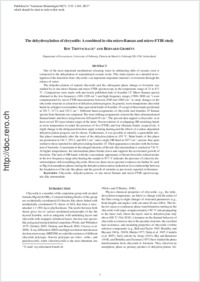The dehydroxylation of chrysotile: A combined in situ micro-Raman and micro-FTIR study
- Trittschack, Roy Department of Geosciences, University of Fribourg, Switzerland
- Grobéty, Bernard Department of Geosciences, University of Fribourg, Switzerland
-
07.01.2013
Published in:
- American Mineralogist. - 2013, vol. 98, no. 7, p. 1133–1145
English
One of the most important mechanisms releasing water in subducting slabs of oceanic crust is connected to the dehydration of serpentinized oceanic rocks. This study reports on a detailed investigation of the transition from chrysotile—an important serpentine mineral—to forsterite through the release of water.The dehydroxylation of natural chrysotile and the subsequent phase change to forsterite was studied by in situ micro-Raman and micro-FTIR spectroscopy in the temperature range of 21 to 871 °C. Comparisons were made with previously published data of lizardite-1T. Micro-Raman spectra obtained in the low-frequency (100–1200 cm−1) and high-frequency ranges (3500–3800 cm−1) were complemented by micro-FTIR measurements between 2500 and 4000 cm−1 to study changes in the chrysotile structure as a function of dehydroxylation progress. In general, room-temperature chrysotile bands lie at higher wavenumbers than equivalent bands of lizardite-1T except of three bands positioned at 301.7, 317.5, and 345.2 cm−1. Different band assignments of chrysotile and lizardite-1T Raman spectra from literature are compared. The most striking assignments concern the three aforementioned Raman bands and those lying between 620 and 635 cm−1. The present data support a chrysotile- or at least curved TO layer related origin of the latter. Deconvolution of overlapping OH stretching bands at room temperature revealed the presence of five (FTIR) and four (Raman) bands, respectively. A slight change in the ditrigonal distortion angle α during heating and the effects of a radius-dependent dehydroxylation progress can be shown. Furthermore, it was possible to identify a quenchable talc-like phase immediately after the onset of the dehydroxylation at 459 °C. Main bands of this phase are positioned at 184.7, 359.2, and 669.1 cm−1 and a single OH band at 3677 cm−1, and are thus quite similar to those reported for dehydroxylating lizardite-1T. Their appearance coincides with the formation of forsterite. A maximum in the integral intensity of the talc-like intermediate is reached at 716 °C. At higher temperatures, the intermediate phase breaks down and supports the accelerated growth of forsterite. The lack of OH bands with the concomitant appearance of broad chrysotile-related modes in the low-frequency range after heating the sample to 871 °C indicates the presence of a heavily disordered phase still resembling chrysotile. However, there are no spectral evidences for further Si- and/or Mg-rich amorphous phases during the dehydroxylation and no indications for a relationship between the breakdown of the talc-like phase and the growth of enstatite as previously reported in literature.
- Faculty
- Faculté des sciences et de médecine
- Department
- Département de Géosciences
- Language
-
- English
- Classification
- Mineralogy
- License
-
License undefined
- Identifiers
-
- RERO DOC 117989
- DOI 10.2138/am.2013.4352
- Persistent URL
- https://folia.unifr.ch/unifr/documents/303196
Statistics
Document views: 116
File downloads:
- pdf: 302
